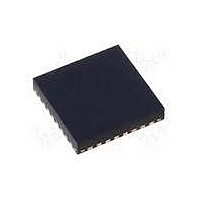MAX15048ETJ+ Maxim Integrated Products, MAX15048ETJ+ Datasheet - Page 24

MAX15048ETJ+
Manufacturer Part Number
MAX15048ETJ+
Description
IC CTRLR PWM STP-DN TRIPL 32WQFN
Manufacturer
Maxim Integrated Products
Datasheet
1.MAX15048ETJ.pdf
(31 pages)
Specifications of MAX15048ETJ+
Applications
Power Supply Controller, Sequencer
Voltage - Supply
4.7 V ~ 23 V
Current - Supply
6mA
Operating Temperature
-40°C ~ 85°C
Mounting Type
Surface Mount
Package / Case
32-WQFN Exposed Pad
Number Of Outputs
3
Output Voltage
5 V
Input Voltage
4.7 V to 23 V
Supply Current
6 mA
Switching Frequency
200 KHz
Mounting Style
SMD/SMT
Maximum Operating Temperature
+ 85 C
Minimum Operating Temperature
- 40 C
Lead Free Status / RoHS Status
Lead free / RoHS Compliant
Voltage - Input
-
Lead Free Status / Rohs Status
Lead free / RoHS Compliant
Triple-Output Buck Controllers
with Tracking/Sequencing
As with the previous example, the actual gain and phase
response is overlaid on the power modulator’s asymp-
totic gain response. It is readily observed that the more
dramatic gain and phase transition at or near the power
modulator’s resonant frequency, f
response of the previous example. This is due to the
component’s lower parasitics leading to the higher fre-
quency of the inherent ESR zero of the output capacitor.
In this example, the desired crossover frequency occurs
below the ESR zero frequency.
In this example, a compensator with an inherent midfre-
quency double-zero response is required to mitigate the
effects of the filter’s double-pole. Such is available with
the Type III topology.
Figure 4d. Power Modulator (High-Quality C
24
_____________________________________________________________________________________
-20
-40
-60
-80
80
60
40
20
0
LC
|G
E/A
, vs. the gentler
|
OUT
) and Type III Compensator Responses
< G
< G
FREQUENCY (Hz)
MOD
E/A
f
LC
As demonstrated in Figure 4d, the Type III’s midfrequen-
cy double-zero gain (exhibiting a +20dB/decade slope,
noting the compensator’s pole at the origin) is designed
to compensate for the power modulator’s double-pole
-40dB/decade attenuation at the desired crossover fre-
quency, f
In the above example, the power modulator’s inherent
(midfrequency) -40dB/decade rolloff is mitigated by
the midfrequency double-zero’s +20dB/decade gain to
extend the active regulation gain bandwidth of the volt-
age regulator. As shown in Figure 4d, the net result is an
approximate doubling in the regulator’s gain bandwidth
while providing greater than 60° of phase margin (the
difference between G
at crossover, f
|G
MOD
|
fJ
CO
f
ZERO, ESR
(again, G
CO
).
E/A
E/A
and G
+ G
MOD
MOD
270
203
135
68
0
-68
-135
-203
-270
= 0dB at f
respective phases
CO
).












